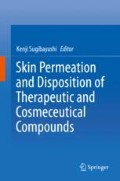Abstract
The use of animals in the testing of cosmetics and their ingredients was banned as of 11 March 2013, in accordance with the 7th Amendment to the Cosmetics Directive. In effect, any cosmetic product that was itself tested or contains an ingredient that was tested using animals cannot be put on sale in the EU. At this time, only a few alternative methods have been developed for testing skin toxicity. Much time and investment is still needed for the development of in vitro tests that are acceptable from a regulatory perspective, therefore we strongly feel the need for further international deliberation on the EU directive and on the handling of cosmetic products developed in places where no animal testing continues.
Access this chapter
Tax calculation will be finalised at checkout
Purchases are for personal use only
References
Commission Staff Working Documents; Time Tables for the phasing-out of animal testing in the framework of the 7th Amendment to the Cosmetics Directive (Council Directive 76/768/EEC); EN, SEC82004)1210(2004)
Adler, S., et al (2011) Alternative (non-animal) methods for cosmetics testing: current status and future prospects-2010. Arch Toxicol 85(5):367–485
ICH (2016) Available at: http://www.fda.gov/ScienceResearch/SpecialTopics/RunningClinicalTrials/GuidancesInformationSheetsandNotices/ucm219488.htm
ICCR (2016) Available at: http://www.fda.gov/Cosmetics/InternationalActivities/ICCR/default.htm
ICATM (2016). International Cooperation on Alternative Test Methods. Available at: http://iccvam.niehs.nih.gov/about/icatm.htm.
JaCVAM (2016). Japan: Japanese Center for the Validation of Alternative Methods. Available at: http://www.jacvam.jp/en/
EURL ECVAM (2016). European Union Reference Laboratory for alternatives to animal testing (EURL ECVAM). Available at: ihcp.jrc.ec.europa.eu/our_labs/eurl-ecvam.
ICCVAM (2016). The Interagency Coordinating Committee on the Validation of Alternative Methods (ICCVAM). Available at:http://iccvam.niehs.nih.gov/
KoCVAM (2016). Available at: http://www.nifds.go.kr/nifds/01_about/about08/about08_04a_a.jsp.
Russell, WMS, Burch, RL., Available at: http://altweb.jhsph.edu/pubs/books/humane_exp/het-toc (1959)
OECD Series on Testing and Assessment (2000) Guidance document on the recognition, assessment and use of clinical signs as humane endpoints, No.19
OECD Test Guideline (2016) Available at: http://www.oecd.org/document/40/0,3746, en_2649_34377_37051368_1_1_1_1,00.html
OECD Series on Testing and Assessment (2016) Guidance Document for the Use of Adverse Outcome Pathways in Developing Integrated Approaches to Testing and Assessment (IATA), No.260
OECD Series on Testing and Assessment (2013) Guidance Document on Developing And Assessing Adverse Outcome Pathways, No.184
OECD Series on Testing and Assessment (2014) Guidance Document for Describing Non-Guideline In Vitro Test Methods, No. 211
Author information
Authors and Affiliations
Corresponding author
Editor information
Editors and Affiliations
Rights and permissions
Copyright information
© 2017 Springer Japan KK
About this chapter
Cite this chapter
Kojima, H. (2017). Related Topic: Safety Evaluation and Alternatives to Animal Testing for Skin Toxicity. In: Sugibayashi, K. (eds) Skin Permeation and Disposition of Therapeutic and Cosmeceutical Compounds. Springer, Tokyo. https://doi.org/10.1007/978-4-431-56526-0_27
Download citation
DOI: https://doi.org/10.1007/978-4-431-56526-0_27
Published:
Publisher Name: Springer, Tokyo
Print ISBN: 978-4-431-56524-6
Online ISBN: 978-4-431-56526-0
eBook Packages: Biomedical and Life SciencesBiomedical and Life Sciences (R0)

